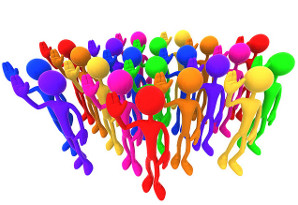
Republicans repeatedly urge Democrats to meet them in the middle—a middle which keeps moving further and further to the right of an ideological center. And Democrats, in an effort to show bipartisanship, have willfully obliged. Norman Goldman wrote in the Huffington Post this week that Dems need to rebrand themselves. They should stake out the true center and demand the GOP meet them there. However, while this is a fine high-minded principle, it ignores a fundamental law of physics that Republicans are exploiting to their advantage.
Nature abhors a vacuum.
In the two-party system that defines American government, the true middle is simply the dividing point between the parties. The Democrats cannot pull their party left and leave a void in the middle. They can only pull left if the Republicans are malleable enough to slide left and fill the gap. This is more like a tug of war where one side can move only if they can budge the other.
The GOP has made ideological purity a concerted goal, and has succeeded in pulling the Democrats to where they are spread across a wide ideological spectrum. Now on the one hand, it might seem that conceding all that real estate to the left was a bad strategy. However, the result has been the ability for the right to adopt an almost unified policy stance on almost every issue. Meanwhile, the left, and its ever growing and unwieldy big tent, struggled to find a position they could all agree on.
The result being a focused Republican party up against fractured and divided Democrats. At this point, the GOP is entrenched. They will not be drawn over their lines. The only way Democrats can redefine the center is if the GOP breaks ranks. Something increasingly plausible as the Tea Party Coalition’s new strength in Congress is now threatening a suicide bomber approach by trying to hold the country hostage over raising the debt ceiling. If they are able to detonate that bomb (not raise the ceiling), the economic impact would be devastating to everyone, regardless of ideology or party. While many Republicans recognize and enjoy the increased power of party purity, far fewer are willing to die for the cause.
Yet for Democrats to exploit this opportunity means they would also have to be willing to die for the cause rather than move the line. Recent history suggests this isn’t remotely true, and the GOP knows this all too well. This is far more likely to result in yet another step to the right for the political center of the two parties.
Where does all this lead? I’ll defer to this allegory that uses crayons to illustrate where we are headed.
Once upon a time there was a box of crayons, one for every color of the rainbow. Green was widely known as the middle of the spectral set, with Red, Orange, and Yellow to one side and Blue, Indigo, and Violet to the other. People recognized the value of the diversity of colors and accepted that to behold the world in all its glory all the colors played a role. Sure, people had their favorites. Some loved the bold hues of the reds, others the compassion of the blues, while many gravitated to the natural greens of the center. There was balance and harmony.
But one day things began to change. The Reds began by chiding the Greens, and eventually the Yellows as well, for not being Red enough. Some, compelled by the pressure, began to change their hue. They shifted red over time and melded with the Red crayon causing it to grow. But this left a spectral void. So the Greens and Blues began to divide and shift their own hues until eventually, the group that used to span from Violet to Blue- Green, now encompassed all the Green and the Yellow as well. Each crayon was smaller, but the void was comfortably filled such that the world could retain its full color.
The Reds, still confident they represented half the spectrum, even if only by weight, decided the new middle must be somewhere in the neighborhood of light Orange. This made even a nice shade of Aqua seem distant and radical.
Before long, the Reds became so emboldened by their uniformity and enormity they started advocating that the world exist only in shades of Red. Their followers, even those whose world depended on tints of all types, began to paint only in Reds and eschew other colors as evil. They mocked the other colors for failing to agree on a single shade. They relished their monochromatic view of the world.
For awhile, the Reds seemed an unstoppable force. Their unity, their single mindedness, their size made them formidable. Over time, the sun, the skies, the grasses, the seas all became Red. But red suns burn cooler, and red chlorophyll doesn’t photosynthesize as well. The world cooled and the air became foul. The vibrant spectrum of life dwindled until eventually the world was, as the Reds had envisioned, a uniform color. But not red. Rather, an amalgam of all colors… lifeless brown.
